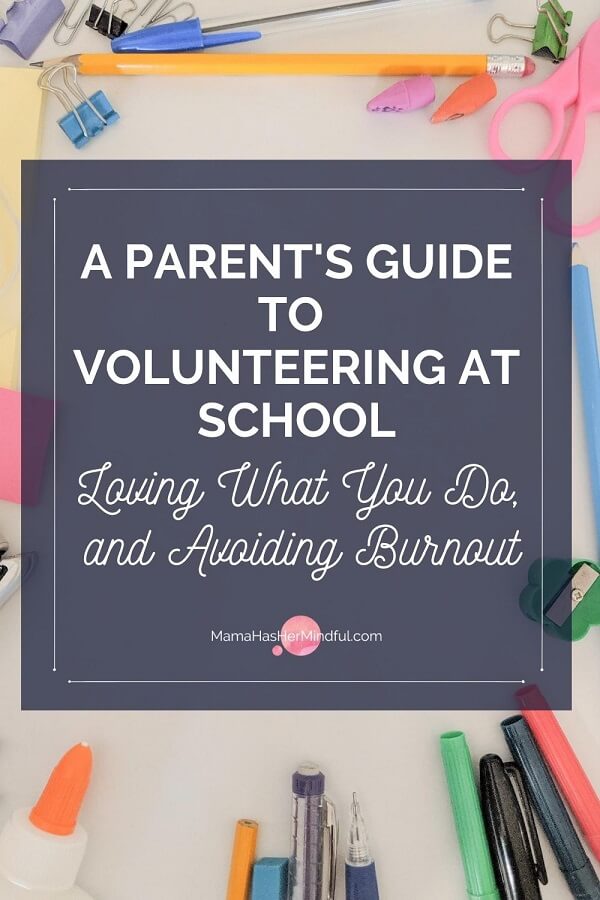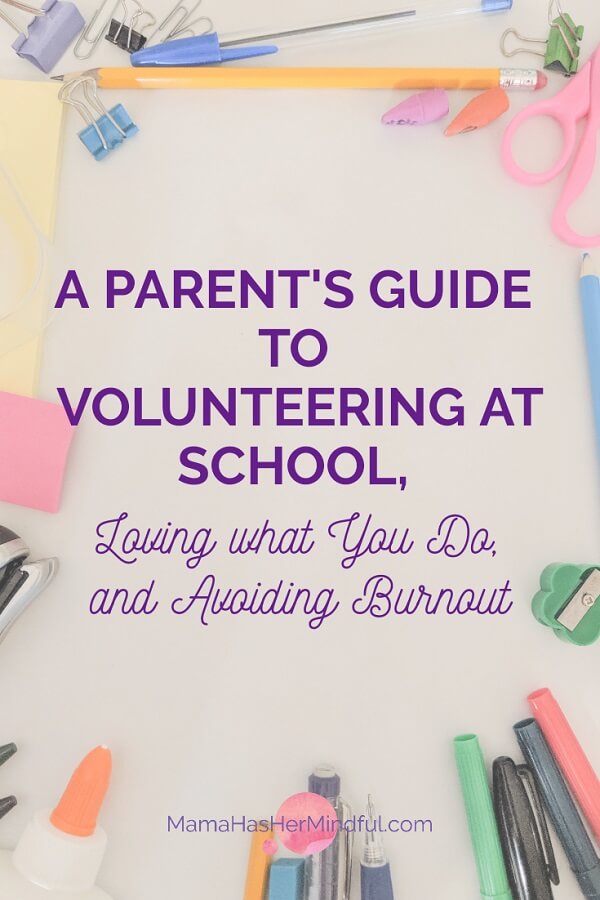So, you want to start volunteering at your child’s school? Great! Schools need more volunteers!
But, where do you start?
Who do you talk to about volunteering?
What tasks are available that you’d enjoy?
Will anything work with your limited availability?
I’ve volunteered in schools for almost a decade. I stumbled my way through various volunteer positions and tasks, and have been a parent association executive board member.
I’ve put together these steps to help parents like you become a volunteer at your child’s school, enjoy the task(s) you assist with, and prevent burnout!
1. Brainstorm how you can help and what you’d like to do.
You know you want to volunteer, and that’s fantastic! But let’s fine-tune what volunteering may look like for you. Ask yourself these questions:
- “What am I good at?”
- “What do I enjoy doing?”
- “What resources do I have that may help the school?” (For example, maybe you work in construction and have power tools and the know-how to build things, such as booths for the school carnival. Or maybe you have a computer at home and can easily make updates to the website and social media pages.)
- “Do I enjoy working with children or would I rather volunteer with tasks outside of the classroom that don’t require me to work with the students?”
These questions may remind you of the questions you ask yourself before you apply for a job. And although volunteering isn’t a job, we want to take this seriously. You want to enjoy the work you’re doing—especially since you won’t be paid.
Another reason identifying your unique skills, assets and resources first is important, is because you’ll have a better idea of how you can benefit the school.
2. Honestly assess your availability.
By volunteering, you are sacrificing your time. And your time is valuable. Before you commit to anything, ask yourself these questions:
- “How much time do I have to volunteer?”
- “Am I available to volunteer on campus during the school day?”
- “Can I help at evening and weekend events?”
- “Am I available to complete volunteer tasks at home?”
It’s easy to say “yes” to everything. You also may not want to miss out on seeing all the fun activities the school has planned. (Or watching your kid enjoy all those fun activities.)
But over-committing can lead to a slew of problems: exhaustion, resentfulness towards those who aren’t volunteering as much as you, a messy house, a spouse who is fed up with a messy house, and time away from other members of your family—such as your other children.
You want to be dependable so staff and students know they can trust and rely on you. Only sign up for what’s realistic with your schedule.

3. Overcome nerves and any preconceived opinions and join the PTA, PTO, PTSA or PTSO.
Most schools have a parent teacher organization or association, also known as a PTO or PTA. (In secondary schools it’s often called a parent, teacher, and student organization or association, or PTSO or PTSA.) Some schools may refer to this group as a parent teacher group (PTG), parent communication council (PCC), or a home and school association (HSA).
Since the point of this post isn’t about the differences between the various groups, I’ll refer to all school parent groups generically as either PTO or PTA.
A lot of parents are hesitant to join their school’s PTA. Most parents I talk to think that by joining the association, they also agree to volunteer at every event.
But that’s SO not the case.
By signing up for your school’s PTA, you’re:
- Not promising to volunteer at anything.
- Paying a small fee (usually anywhere from $5-$10) that contributes to fun and educational programs for your child and all students on campus.
- Making it WAY easier to locate volunteer opportunities you may enjoy.
You’re reading this post to learn how to volunteer at your kid’s school. And joining the school parent group is a surefire way to find volunteer opportunities. The folks who run your PTO or PTA are the same people who run most of the events and programs at school. And if they already know you and what you’re able to help with, they’ll gladly reach out when they need assistance.
4. Know what the school and parent group are up to.
Knowing what goes on beyond the event calendar is another way to learn about volunteer positions in advance. Follow these tips for staying in touch with the parent board and school:
- Consider attending PTA association meetings. Association meetings cover upcoming events, the budget, calls for volunteers, and more. Sometimes they occur in the evening before Back to School Night or Open House. Sometimes they occur in the morning right after the students go to class.
Before you attend, however, make sure you joined the association (Step 3). In some cases, it’s a requirement to be at a meeting. Attending one of these meetings is also another opportunity to introduce yourself to the executive board members. - If your PTO or PTA is on social media, follow them. It’s a great way to stay up to date, see volunteer requests, and ask questions.
- If your school sends out a weekly packet or newsletter, read it. Chances are, they’ll list calls for volunteers for upcoming events and activities.
If you don’t know what’s coming up at the school, you won’t have a chance to put your name on any volunteer lists, so stay in the know!
5. Complete a volunteer application and/or necessary paperwork.
Before you start volunteering, you’ll need to fill out an application with your school’s office before you’re allowed to help with any activities on campus.
Be prepared to provide:
- A copy of your driver’s license
- Background information, specifically any convictions
- Possibly vaccination records if you volunteer over a certain number of hours
This is usually only required once a school year, so after you complete it the first time, you’re covered until the following year.
6. Score the volunteer opportunities you want.
There are lots of ways to volunteer with your kid’s school. But, where do you find those positions? They are commonly found:
- In flyers or forms calling for volunteers
- By asking the parent group or other involved parents
- By inquiring with staff or the teacher
In the beginning of the school year, look out for an initial volunteer request. Usually you’ll receive a paper flyer or electronic form that lists all of the events and programs that require volunteers throughout the school year.
If you miss this, don’t worry; the school or PTO will reach out again before big events if they’re running low on volunteers. But if you spot the first one, you’ll get first dibs on activities you’re most interested in and available for.
If you don’t see anything like this, send an email to the PTO or PTA, your child’s teacher, or even the office manager. Spread the word that you’re interested in helping out. And if you have something in mind that you’d like to help with, mention that in the email.
If email doesn’t work, verbally ask the staff and other parents. The more people who know you’re interested in volunteering, the more likely you are to land a volunteer position.
7. Help where your child spends most of his time: the classroom.
Many parents want to volunteer in a capacity that directly impacts their child. Working in the classroom is where your child spends the most time.
So if volunteering in class is your goal, introduce yourself to your child’s teacher and express your interest in helping. Ask if they have a list of volunteer tasks they need done.
Classroom tasks may include:
- Preparing materials for classroom activities and projects (photocopying, cutting, filing, etc.)
- Assisting the teacher with projects or assignments
- Working with students to review skills taught in class
- Organizing and cleaning the classroom
- Chaperoning field trips
- Helping at class events and parties
- Being a room parent (working with the teacher to organize class parties and projects and working with the parent board to gather volunteers for school events)
Volunteering in my kids’ classes is my favorite way to volunteer. I get to meet and interact with my kids’ friends and teachers, and I can better understand the material they’re learning.
8. Volunteer with school-wide events, programs and tasks.
If volunteering in the classroom on a regular basis isn’t something you’re interested in, or able to commit to, consider helping with one-time events, programs or specific areas of the school instead.
Here’s a list of tasks your school may need help with:
- Sorting books in the library
- Clerical tasks in the office
- Managing the parent group’s website and/or social media
- Creating flyers and posters
- Assisting on the playground
- Chaperoning dances, field trips, etc.
- Running an after school or lunch time club
- Assisting with projects in the Makerspace
- Helping with an art, gardening, or music program
- Working booths at various evening events
- Decorating for parties and events
Here’s a list of possible events and programs your school may need parents to be a Chair or Coordinator for:
- Jog-a-thon
- Carnival
- Yearbook
- Assemblies
- Red Ribbon Week
- Book Fair
- Holiday Shop
- Hospitality
- Family Nights
- Dances
- Spirit Wear
- Talent Show
- Box Tops
- Teacher/Staff Appreciation Week
- Student Store
- Volunteer Coordinator
- Social Media
- Fundraisers
- Bake Sales
- Room Parents
- Read Across America
Signing up to be a program chair or a volunteer at an event is a great way to meet other parent volunteers and staff members. Plus, you’ll have a chance to see how you like volunteering without dedicating too much time and energy.

9. Courageously become an executive board member for the PTA or PTO.
If you enjoy volunteering, and you want to have a say in the decision-making process, consider becoming an executive board member for your school’s PTA. These positions are elected to office and usually require your attendance at a monthly meeting. Depending on the position, a greater time commitment is also expected. Here are some examples of board positions:
- Historian
- Auditor
- Secretary
- Parliamentarian
- Membership
- Treasurer
- Programs
- Fundraising
- President
I’ve been on my school’s parent teacher association board for five years. And although I am expected to attend a monthly meeting and volunteer at most events, I also get to be a part of the planning process for most, if not all of the events on campus. I enjoy knowing what goes on behind the scenes, so the extra time is totally worth it to me.
10. Don’t get summoned to the principal’s office: Follow the rules!
Schools have rules in place that help the day run smoothly and keep our kids and staff safe. As volunteers, we need to respect those rules.
- Be prepared to sign in when you enter the campus.
- If you are given a badge or name tag, wear it.
- Sign out when you leave and return your badge or name tag.
- Follow any established guidelines and policies the school has in place, such as dress code, behavior, etc.
- Remember, you are not responsible for instructing or evaluating students. Your goal is to enrich and supplement learning for students and support staff in their mission to achieve a successful educational environment.
When you volunteer at events on campus, follow the school rules. Watch your language. Be respectful to staff and students and their belongings. Channel your inner school kid and behave like one.
11. Be a brilliantly effective volunteer.
Look, I know it’s exciting to walk into your kid’s class and be privy to their routine outside of your home. But if you enter the classroom, and the teacher is in the middle of a whole-class instruction, PLEASE don’t shout, “Hello!” to your kid and all his friends.
That is disruptive. And it’s the opposite of an effective volunteer.
If you want to greet your kid, then a quick, quiet wave or smile works just fine and doesn’t distract the students from the learning taking place.
Consider these points to ensure you’re more helpful than distracting while you volunteer:
- Be mindful of the teacher’s classroom management.
- Be understanding and considerate of differences.
- Respect each student’s individuality.
- Cooperate with students, staff and teachers.
- Communicate clearly and kindly with staff, teachers and students.
- Be respectful of the staff and teacher’s responsibility to every students’ health, education and welfare.
- Use sound judgment when making decisions. If you are unsure about the decision, discuss your concerns as soon as possible with a teacher or staff member.
- Be dedicated to continuing the teacher’s or staff member’s goals while you help.
- Respect student and staff confidentiality.
Focus your efforts and work hard while volunteering and the staff and students will notice.
12. Embrace your role as motivator—students already have a teacher.
Remember, it’s not your job to teach or assess. The students have a teacher. If you’re able to motivate students, maintain a positive attitude, and follow the teacher’s lead, you’re off to a great start. Keep these tips in mind when working with students:
- Smile and be positive.
- Give students time to think and work through problems without giving them the answer.
- Be encouraging.
- Refrain from comparing students.
- Refrain from judging their behaviors or abilities.
- Leave the discipline to the teacher and staff.
- Keep comments on the task or activity at hand, rather than on the student. (For example, if a student shows you their work and expects praise, rather than saying “Good boy! You did it!” keep your response on the work, “Wow! You worked hard to complete that. And I see you followed the teacher’s instructions and put periods at the end of your sentences.”)
- Don’t favor your kid. But don’t be too hard on them either.
- Don’t treat your kid with all the love in the world and be ho-hum about everyone else. Remember, not every student has a parent who is able to spend their time in the classroom.
- Understand mistakes happen and from mistakes, comes growth. So adopt a growth mindset.
Use your time volunteering as an opportunity to build relationships with all students—not just your child. You’ll start to notice that as you interact respectfully with students, it will build trust and camaraderie.
13. Show up!
I can’t tell you how often one of my kids’ teachers tell me that they’re short classroom helpers come January. Parents who promised to volunteer each week all of a sudden stop showing up after the holiday parties.
Keep these in mind regarding attendance:
- If you say you’re going to be in the classroom every Monday from 8-10, be there every Monday from 8-10.
- If you signed up to work the ticket booth at the next school event, be there on time and for as long as you promised.
- If you’re sick, or your child is sick, no worries. Type a quick email to the teacher or leave a message with office staff apologizing that you can’t make it. They’ll understand. And they’ll be appreciative that you told them your plans changed.
- Although this is a volunteer position, treat it with the respect of an actual job.
When you don’t show up, it hurts the very people you signed up to help. Including your child. Sure, the teacher, staff or parents can get along without you. But if they planned an activity that can only be done with the help of an extra pair of hands, and you’re MIA, they need a new game plan.

14. Sincerely evaluate if you want to do this again.
After volunteering, you’ll have an inside view of just how much time other adults dedicate to spending on your child. But just because they do it, doesn’t mean it’s a good fit for you.
Every time you get home after volunteering—and I mean every time—take a moment to reflect on your feelings while you were helping, and how you feel now that you’re home.
- Did you feel energized while working with the students in the classroom?
- Were your creative juices flowing when you designed the art wall display for the library?
- Are you feet tired from standing up for so long at the bake sale?
- Are you overstimulated from counting laps as kids ran around the track, listening to loud music, refilling water stations, and tying shoes for hours at the jog-a-thon?
It’s OK if you leave questioning whether or not you want to volunteer in that capacity again. And it’s OK if you decide you don’t want to volunteer anymore.
What’s not OK is if you continue to put yourself in a situation that you don’t enjoy. That’s why it’s critical that you do this step after any time you volunteer. Because a volunteer position may be enjoyable today, but a month from now, you may be over it.
And that’s what leads to burnout—something we want our volunteers to avoid!
15. Avoid burning out.
By following most of the earlier steps, you’ll have thought through how you want to volunteer, and therefore are on your way to preventing burnout. But there are a few other factors every school volunteer should remember.
- Do what you love. If the task you’re volunteering for isn’t in your wheelhouse, you’ll burnout quickly. The work will start to feel like a chore. So, like we discussed in Step 1, ask yourself how you want to volunteer. Find something you like doing so that your inspiration for volunteering sticks around.
- Manage your time wisely. Don’t overbook yourself. As volunteers and parents, it’s especially important for us to have balance in our life. Be generous with how much time you need to clean your house, run errands, take care of other children, work, etc.
If you try to cram too much into your schedule, you’ll find yourself cutting something out. Whether it be housecleaning, work or personal time.
And that’s where resentment sets in.
You’ll begin to resent other parents for not volunteering as much as you. Or the school for asking so much of you. Or your kids because they don’t realize how much you’re helping at their school.
And once that ugly beast known as resentment rears its head, it’s tough to tame. Those negative thoughts will keep swirling around in your head until you make a change.
- Master the art of saying, “No.” Nobody wants to be a “no” man. But as parents, we’re busy people! And our kids come first.
Once you open the door to being a volunteer, it’s inevitable that the school and parents will ask more of you.
Don’t be afraid to be honest and firm with your response. If you’re able to volunteer more, great! But if you have other important commitments in your life that make helping at the school stressful for you, it’s OK to admit that.
If the staff and parent board can’t understand that, it may hurt your feelings. But if you’ve weighed what’s more important to you, and it’s not volunteering, then have faith in your decision. It’s what’s best for you and your family.
Taking care of yourself so that you don’t drain your volunteer batteries is critical to ensuring a long, happy volunteer experience.
That’s it! Now you’re ready to put yourself out there and start volunteering at your child’s school!
I’m Curious About Your Volunteer Story….
If you’re already volunteering at a school, or have plans of volunteering at a school, I’d love to hear from you. Let me know your answers to these three questions:
- What volunteer work do you do (or want to do) at your kid’s school?
- Why is it so important to you to become a school volunteer?
- How do you (or how do you plan to) deal with burnout?
I look forward to hearing from fellow school volunteers in the comments below!
Stay mindful, even when your mind’s full,
Chelsea






1 comment
This is an awesome list! From the standpoint of a teacher and a parent, it was a great reference. Thanks!